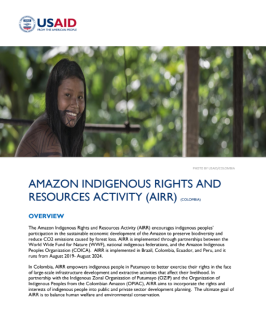OVERVIEW
The Amazon Indigenous Rights and Resources Activity (AIRR) encourages indigenous peoples’ participation in the sustainable economic development of the Amazon to preserve biodiversity and reduce CO2 emissions caused by forest loss. AIRR is implemented through partnerships between the World Wide Fund for Nature (WWF), national indigenous federations, and the Amazon Indigenous Peoples Organization (COICA). AIRR is implemented in Brazil, Colombia, Ecuador, and Peru, and it runs from August 2019- August 2024.
In Colombia, AIRR empowers indigenous people in Putumayo to better exercise their rights in the face of large-scale infrastructure development and extractive activities that affect their livelihood. In partnership with the Indigenous Zonal Organization of Putumayo (OZIP) and the Organization of Indigenous Peoples from the Colombian Amazon (OPIAC), AIRR aims to incorporate the rights and interests of indigenous people into public and private sector development planning. The ultimate goal of AIRR is to balance human welfare and environmental conservation.
GOALS
STRENGTHEN INDIGENOUS COMMUNITIES’ CAPACITIES
AIRR strengthens indigenous peoples’ capacity to advocate for their rights. AIRR also strengthens indigenous communities’ capacities to better monitor their lands and identify the negative impacts of infrastructure and extractive industry development
PROMOTE ENVIRONMENTALLY SUSTAINABLE DEVELOPMENT
AIRR helps existing indigenous enterprises to grow and helps indigenous communities to consolidate their businesses to reach regional, national, and international markets. It does this through a combination of grants, loans, and market analysis.
ANTICIPATED RESULTS
- Train indigenous leaders and communities in strategic planning, conflict resolution, social inclusion and legal rights;
- Engage indigenous leaders in new consultation and dialogue processes with public and private stakeholders to mainstream indigenous communities’ priorities in regional development;
- Help indigenous communities establish compliance monitoring systems to produce environmental impact and compliance reports for infrastructure and extractives activities in areas of high conservation value; and
- Improve the management practices of at least six indigenous enterprises in Putumayo and increase at least two enterprises’ product quality and quantity to meet the demands of new markets and buyers.
| Contact Information |
|---|
| Monica Romo E-mail: mromo@usaid.gov |

